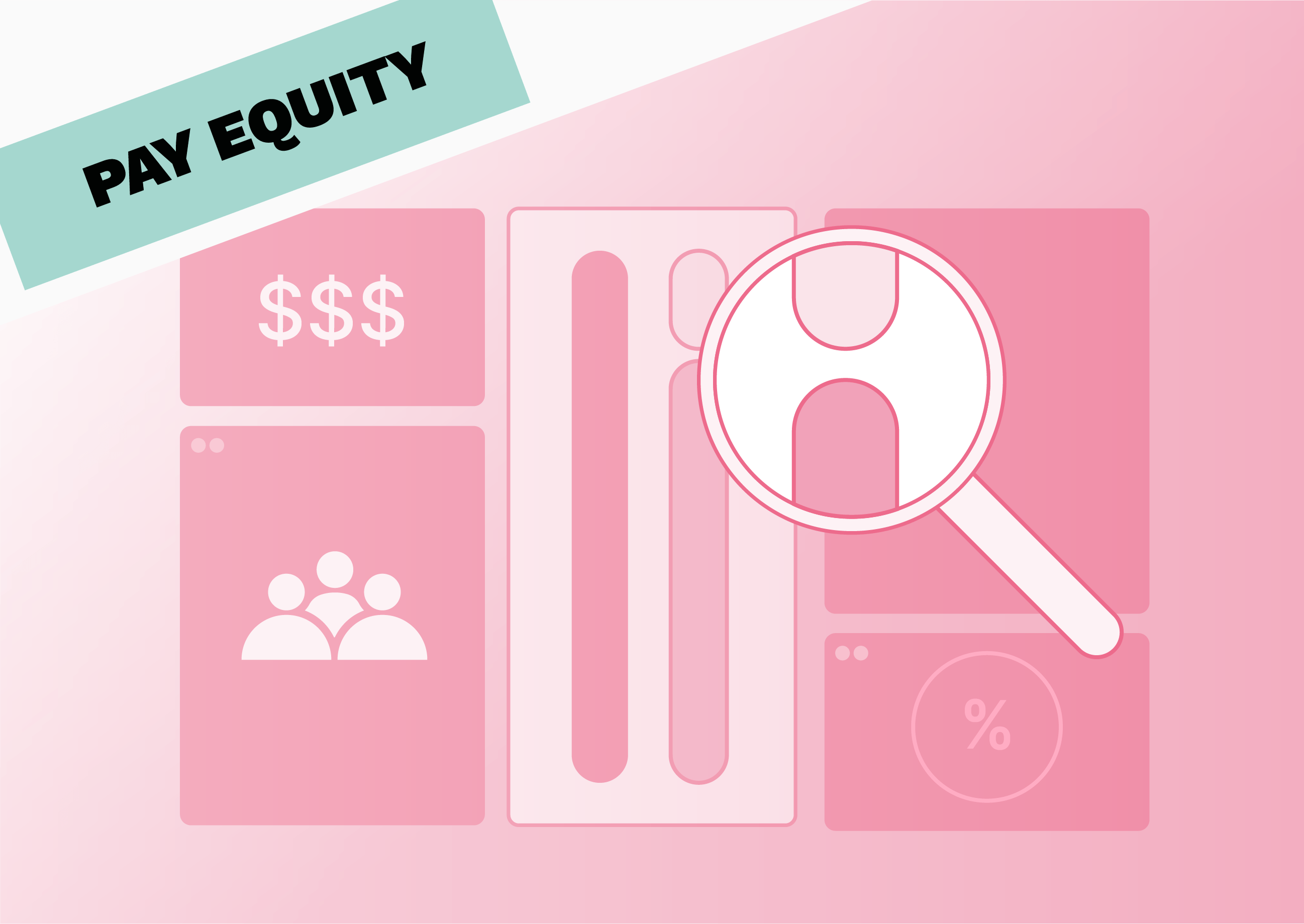Pay equity and the gender pay gap are related concepts — but they’re not the same thing. In fact, many companies have persistent gender pay gaps even though their pay practices are 100% equitable and fair.
In this article, we’ll dive into the differences between pay equity and the gender pay gap and explore how they interplay with each other. We’ll also touch briefly on how the EU Pay Transparency Directive will have an impact on both issues.
What is pay equity?
Pay equity is the concept of paying men and women equally for the same or similar work. In law, the key concept is ‘equal pay for work of equal value’. That means it’s not just about comparing the salaries of employees with the same job title, but also those whose work is substantially similar in terms of qualifications, working conditions, skills and responsibility level.
Companies can measure their level of pay equity by comparing the average pay of men and women within a particular group (e.g. engineers), after adjusting for factors like seniority, experience and location. If there are still differences between men and women’s pay after controlling for all relevant factors, pay inequity could be at play.
What is the gender pay gap?
The gender pay gap is the difference between the average pay of all men vs. all women within an organisation or a country. For example, the average gender pay gap in the EU is around 13% according to the latest figures.
Various factors contribute to the gender pay gap. For example, there are fewer women in higher-level positions than men. Roles that have historically been filled by women also tend to pay less than those favoured by men. When an organisation has a gender pay gap, it doesn’t necessarily mean that their pay practices are inequitable. However, this is a factor in some organisations.
What about the adjusted gender pay gap?
Here’s where things get a bit more complicated: the above is a description of the unadjusted gender pay gap. It compares all men’s pay with all women’s pay within an organisation (or a country). An adjusted gender pay gap, on the other hand, is measured after controlling for factors that influence pay, such as job role, education, experience, and location.
The adjusted gender pay gap is a much better measure of pay equity than the adjusted gender pay gap. After all, there are many possible reasons that a company might have an unadjusted gender pay gap — we’ll discuss some of them below. But if these problems persist even after controlling for objective factors, pay inequity is likely a big part of the problem.
The reasons behind the gender pay gap
On a country level, there are a lot of reasons behind the gender pay gap, and only some of them are within the control of individual employers. Here are some of the biggest contributing factors:
- Pay inequities: While the gender pay gap isn’t all about pay inequity, there’s no doubt that it plays a role. Companies that want to tackle their gender pay gap should first ensure their pay practices are ethical and that discrimination and unconscious bias aren’t having an impact.
- Stereotypes and low-paid fields: Men and women are often steered towards particular occupations. And those that attract more men are typically better paid than those favoured by women. For example, care-focused work, which is predominately done by women, is often thought of as ‘soft-skilled’ and therefore pays less than work in traditionally masculine fields.
- The glass ceiling: Most employers have a fairly equal balance of men and women at the entry-level. But the percentage of women drops for every level climbed within the organisation. According to McKinsey’s 2024 Women in the Workplace report, women made up 48% of entry-level employees, but just 29% of the C-Suite (and the situation is even worse for women of colour). This is an effect known as the ‘glass ceiling’ since it acts as an invisible barrier that many women are unable to cross.
- Impact of part-time and casual work: Women are more likely than men to work part-time, which typically pays less per hour than full-time work. This is often because of childcare or other caregiving responsibilities. Around the world, women are also overrepresented in the informal sector, which has a significant impact on average earning potential.
- The motherhood penalty: Lastly, women are much more likely than men to take time out of the workforce to raise children, which can impact their long-term career prospects. This is known as the ‘Motherhood Penalty’. Of course, it often makes sense for the female partner in a couple to stop working precisely because she already earns less than her partner, which compounds the problem over time.
{{cta}}
Reasons behind inequitable pay
It’s easy to assume that if a company is struggling with pay inequity, it must be deliberately discriminating against female workers — but that’s not always the case. Here are some of the reasons a company may have pay equity problems:
- Pay discrimination: First, there’s no denying the fact that some companies are actively discriminatory in the way they determine pay and award bonuses and raises. However, this is thankfully quite rare (as well as being illegal in most countries). Setting strict pay criteria and ensuring they’re adhered to can help ensure that discrimination by individual decision-makers doesn’t have an impact on an organisation’s pay equity.
- Unconscious bias: A much more prevalent problem is unconscious bias, which is all about the assumptions and associations our brains make without us being aware of them. In terms of pay equity, this might look like paying a man a high salary due to his ‘potential’ but requiring a woman to prove herself first. According to some studies, a person’s bias can even be incompatible with their conscious thoughts — making it a tricky problem to solve.
- Unfair hiring practices: An organisation’s hiring practices can have a significant impact on pay equity. For example, basing new employees’ salaries on their previous compensation only perpetuates existing inequities. Salary negotiations are also a contributing factor since there’s evidence that women are less likely to negotiate than men. Lastly, leaving pay decisions to individual managers instead of setting clear and consistent criteria can also have an impact, because it leaves room for unconscious bias.
How to tackle pay inequities and the gender pay gap
Here’s how employers can get a handle on both inequitable pay and the gender pay gap, one step at a time.
1. Understand your problem
The first step in resolving your equal pay issues is understanding the problem you have. Calculating your gender pay gap is fairly easy: you just need to work out the average pay of all men and all women within your organisation, then express the difference as a percentage of the average pay for men.
Assessing your pay equity situation is a bit more difficult, as it requires you to carry out a full pay equity analysis. This is a statistical process that allows you to identify inequities and even uncover the reasons behind them.
2. Start with pay inequities
While pay inequities are not the only factor behind the gender pay gap, they’re an important driver in many organisations. Thankfully, they’re also one of the simplest problems to solve because they’re entirely within your control as an employer.
Once you’ve completed a pay equity analysis, you should understand which pay differences are due to justifiable reasons (like an employee’s performance, tenure or location) and which are down to unjustifiable ones (like their gender). The only thing left to do is to correct the inequities by bringing those underpaid employees’ salaries in line with those of their colleagues doing the same or similar work.
3. Eliminate possibilities for bias
Another important step in closing the gender pay gap is reducing the impact of unconscious bias on pay decisions. But here’s the thing: unconscious bias is unconscious by definition, which means it’s difficult to tackle through training and education alone.
The solution is to set up systems and processes in such a way that they leave no room for bias, unconscious or otherwise. For example, building a clear, consistent job architecture and assigning salary bands to each role and location helps to standardise pay decisions across the organisation.
You can learn more about unconscious bias and how to tackle it in our full guide.
4. Tackle the ‘opportunity gap’
Even in well-meaning organisations, men and women often do not have equal access to opportunities, including jobs, promotions, pay increases, mentoring, training and other factors that can impact their pay progression. Tackling this ‘opportunity gap’ is one of the most valuable ways of dismantling the gender pay gap within your organisation.
To do this, you’ll need to carefully analyse your recruiting, hiring, onboarding and promotion policies and processes, and identify moments where women are missing out on opportunities. For example, you may find that women and men are promoted equally to the intermediate level, but that women fall behind after that. In this case, you might consider putting in place mentorship programmes specifically to help women climb the ladder.
{{cta}}
Pay equity and the gender pay gap in the context of the EU Pay Transparency Directive
The EU Pay Transparency Directive will be in effect in all member states by June 2026 at the latest. And it will force companies all over Europe to take a closer look at both their gender pay gap and their pay equity standards.
If you want to learn more about the EU Pay Transparency Directive and how to prepare, you’re in the right place. Get started with these articles from our archive:
- Your Pay Transparency Questions Answered: Insights From Our Webinar
- Pay Transparency Directive: A Guide for Employers by 2026
- How Countries Are Implementing the EU Pay Transparency Directive
- The Clock is Ticking on Pay Transparency: Here's How to Prepare
- 5 Barriers to Pay Transparency (And How to Overcome Them)
Summarize this article with AI
No time to read it all? Get a clear, structured, and actionable summary in one click.






